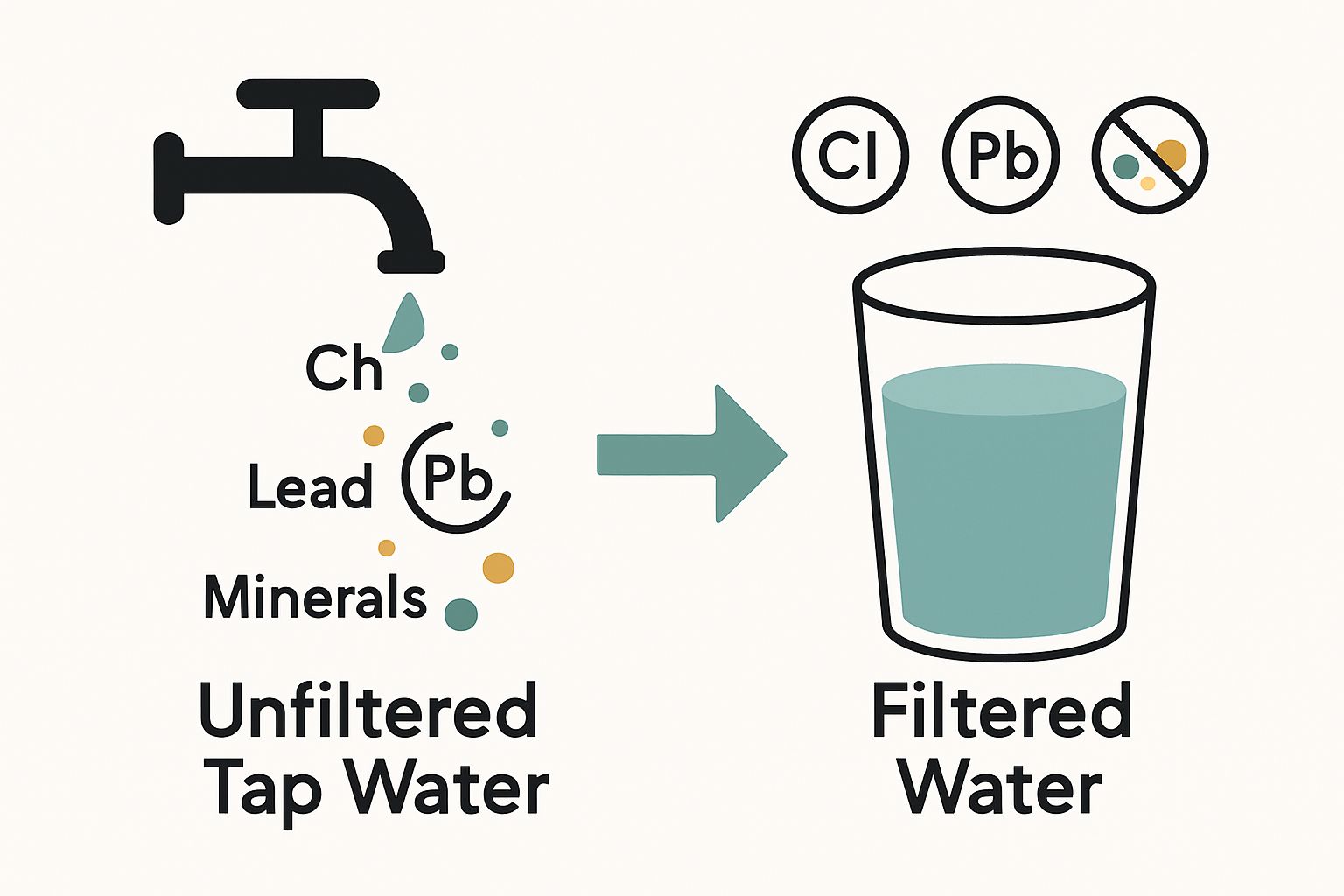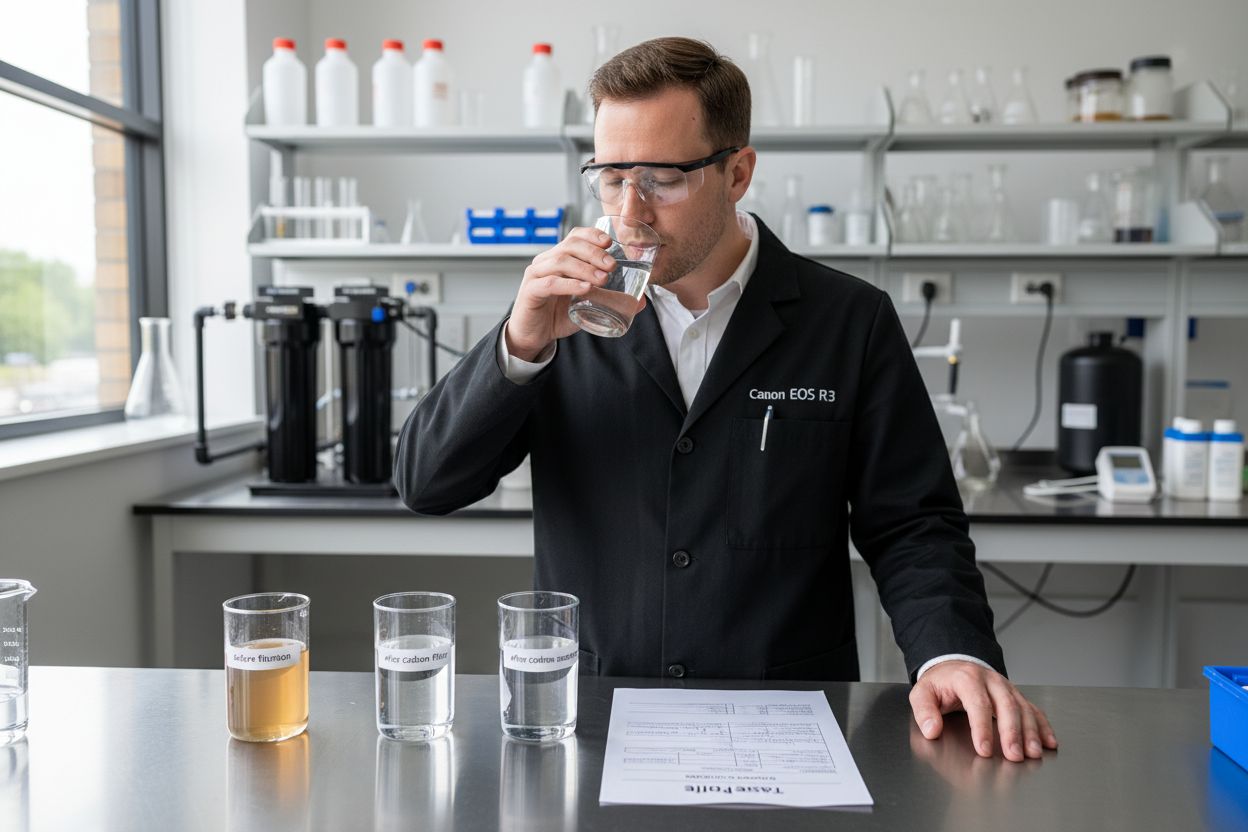Uncategorized
Understanding How Water Filters Affect Taste
Water filters promise more than just clean water and they claim to transform every sip you take at home. Most people think removing dirt and chemicals is enough but there is a surprising benefit you might miss. Professional studies show that advanced water filtration can reduce up to 99% of taste altering contaminants. The real twist? Filters do not just make water safer they actually change the way water tastes in ways your senses might never expect.
Table of Contents
- What Are Water Filters And Their Purpose?
- How Water Filters Change The Taste Of Water
- The Science Behind Taste Alterations In Filtered Water
- Impact Of Water Quality On Flavor Perception
- Choosing The Right Water Filter For Taste Improvement
Quick Summary
| Takeaway | Explanation |
|---|---|
| Understand filter components | Familiarize yourself with key parts like activated carbon and reverse osmosis for better water quality. |
| Know your local water quality | Assess local water characteristics using municipal reports to identify potential contaminants affecting taste. |
| Select the right filter type | Choose a filter based on specific taste improvement needs, such as activated carbon for chlorine removal. |
| Comprehensive filtration improves taste | Effective filtration can reduce contaminants, significantly enhancing the palatability of drinking water. |
| Taste is influenced by minerals and chemicals | Recognize that dissolved compounds like chlorine affect water flavor; filters can mitigate these effects. |
What Are Water Filters and Their Purpose?
Water filters are specialized devices designed to remove impurities, contaminants, and unwanted substances from water, transforming ordinary tap water into a cleaner, safer, and more palatable drinking experience. Our comprehensive guide on water filtration explores the intricate world of these essential home wellness technologies.
The Science Behind Water Filtration
At their core, water filters work through multiple sophisticated mechanisms to purify water. These mechanisms include physical filtration (trapping particles), chemical filtration (removing dissolved contaminants), and sometimes biological filtration (neutralizing microorganisms). The primary goal is multifaceted: improving water quality, enhancing taste, eliminating potential health risks, and ensuring safe consumption.
Key Components of Water Filtration
Water filters typically incorporate several critical components to achieve comprehensive purification:
- Activated Carbon: Absorbs chlorine, sediments, volatile organic compounds
- Ceramic Filters: Blocks microscopic particles and bacteria
- Ion Exchange Resins: Removes hard water minerals
- Reverse Osmosis Membranes: Eliminates dissolved solids and contaminants
According to Environmental Protection Agency research, these components work synergistically to transform potentially unsafe water into a clean, refreshing beverage. By understanding how water filters affect taste, consumers can make informed decisions about their home water treatment solutions, ensuring both safety and sensory satisfaction.
How Water Filters Change the Taste of Water
Water filters do more than simply purify water they fundamentally transform its taste profile by removing various chemical compounds and contaminants that impact flavor. Explore our comprehensive guide on water filtration benefits to understand the intricate relationship between filtration and taste enhancement.
Chemical Compounds and Flavor Alteration
The taste of water is directly influenced by dissolved minerals, chemicals, and organic compounds. Chlorine, for instance, introduces a distinct metallic or swimming pool like flavor. Heavy metals such as lead and copper can contribute bitter or metallic undertones. Water filters strategically target these compounds, effectively neutralizing unpleasant taste elements and creating a cleaner, more neutral drinking experience.
Filtration Mechanisms Affecting Taste
Different filtration technologies impact water taste through unique mechanisms:
- Activated Carbon Filters: Absorb chlorine, sediments, and organic compounds
- Reverse Osmosis Systems: Remove dissolved solids that contribute to mineral taste
- Ion Exchange Filters: Eliminate hard water minerals that create metallic flavors
- Ceramic Filters: Block microscopic particles affecting water clarity and taste
According to National Sanitation Foundation research, professional water quality studies demonstrate that comprehensive filtration can dramatically improve water palatability by reducing up to 99% of taste altering contaminants.
To help readers compare the main filtration technologies discussed and understand how each impacts water taste, the table below summarizes their key features and primary taste improvement functions.
| Filtration Technology | Key Components | Main Targets | Effect on Water Taste |
|---|---|---|---|
| Activated Carbon Filter | Activated carbon | Chlorine, organics, sediments | Neutralizes chlorine, improves freshness |
| Reverse Osmosis System | Semipermeable membrane | Dissolved solids, minerals | Removes mineral taste, delivers clean flavor |
| Ion Exchange Filter | Ion exchange resin | Hard water minerals | Reduces metallic/bitter taste |
| Ceramic Filter | Porous ceramic material | Microscopic particles, bacteria | Improves clarity and texture |
| Multistage Filtration | Combined technologies | Multiple contaminants | Comprehensive taste and quality improvement |

Understanding these scientific principles helps consumers make informed choices about water treatment solutions that enhance both safety and sensory enjoyment.
The Science Behind Taste Alterations in Filtered Water
Water taste is a complex sensory experience influenced by molecular interactions and chemical compositions. Learn more about essential water filter types to understand the sophisticated science behind flavor transformation.
Molecular Interactions and Flavor Perception
Taste perception occurs when dissolved compounds interact with taste receptors. Different chemical structures contribute distinct flavor profiles. Minerals like calcium and magnesium create hardness, while chlorine and organic compounds introduce metallic or earthy notes. Water filters interrupt these molecular interactions, selectively removing compounds that generate undesirable taste sensations.
Chemical Removal and Sensory Transformation
Filters employ sophisticated mechanisms to modify water’s chemical composition:
- Adsorption: Activated carbon captures flavor altering molecules
- Ionic Displacement: Ion exchange resins swap unpleasant mineral ions
- Molecular Separation: Reverse osmosis membranes block taste impacting compounds
- Physical Filtration: Ceramic filters eliminate microscopic particles affecting flavor
According to American Chemical Society research, chlorine molecules are particularly significant in water taste modification. By strategically removing these compounds, water filters create a cleaner, more neutral sensory experience that allows natural water characteristics to emerge without interference from contaminant induced flavors.
Impact of Water Quality on Flavor Perception
Water quality plays a pivotal role in determining the overall sensory experience of drinking water. Discover the advantages of advanced home water purification to understand how water quality directly influences taste perception and enjoyment.
Chemical Composition and Sensory Experience
Water is not a uniform substance but a complex mixture of minerals, dissolved gases, and trace elements. Each geographic region presents unique water characteristics influenced by local geological conditions. Groundwater passing through limestone regions carries different mineral profiles compared to water from volcanic areas. These variations create subtle yet distinctive flavor nuances that discerning palates can detect.
The following table outlines core factors that influence the flavor profile of drinking water, helping readers connect chemical composition and external influences to taste perception.
| Factor | Description | Impact on Flavor Profile |
|---|---|---|
| Mineral Content | Levels of calcium, magnesium, sodium | Adds hardness, distinct taste |
| Dissolved Gases | Oxygen and carbon dioxide concentrations | Impacts freshness, effervescence |
| Organic Compounds | Algae, bacteria, environmental contaminants | Can introduce earthy or musty notes |
| Industrial Pollutants | Heavy metals, chemical residues | Cause metallic or chemical taste |
| Regional Geology | Local rock and soil composition | Alters mineral mix, unique local flavor |
Factors Affecting Water Flavor Profile
Multiple elements contribute to water’s taste complexity:
- Mineral Content: Calcium, magnesium, and sodium levels
- Dissolved Gases: Oxygen and carbon dioxide concentrations
- Organic Compounds: Algae, bacteria, and environmental contaminants
- Industrial Pollutants: Heavy metals and chemical residues
According to World Health Organization research, water quality directly impacts human perception of taste, with even minute concentration changes potentially altering sensory experiences. Professional water quality assessments reveal that comprehensive filtration not only improves safety but also significantly enhances the natural, clean flavor profile of drinking water.
Choosing the Right Water Filter for Taste Improvement
Selecting an appropriate water filter requires understanding individual water quality challenges and specific taste enhancement goals. Learn about our range of essential water filter types to make an informed decision tailored to your unique water profile.
Assessing Local Water Characteristics
Before selecting a water filter, homeowners must comprehensively evaluate their local water composition. Municipal water reports provide detailed insights into existing contaminants, mineral content, and potential flavor disrupting elements. Factors like regional geology, industrial activities, and water treatment processes significantly influence water’s baseline taste profile and filtration requirements.
Matching Filter Technologies to Specific Taste Challenges
Different water filter technologies target distinct taste improvement objectives:
- Activated Carbon Filters: Best for removing chlorine and organic compounds
- Reverse Osmosis Systems: Ideal for eliminating dissolved solids and minerals
- Ceramic Filters: Effective against microscopic particles affecting water clarity
- Multistage Filtration: Comprehensive approach addressing multiple taste factors
According to National Sanitation Foundation research, professional water quality experts recommend conducting a comprehensive water quality test before filter selection.
 This strategic approach ensures targeted filtration that not only improves taste but also addresses specific regional water composition challenges, delivering a superior drinking water experience.
This strategic approach ensures targeted filtration that not only improves taste but also addresses specific regional water composition challenges, delivering a superior drinking water experience.
Experience the Purest Taste with Coway Water Filtration Solutions
If you have ever been frustrated by the lingering taste of chlorine, metallic undertones, or odd odors in your tap water, you are not alone. The article explained how water filters can completely transform your water’s taste by removing contaminants and chemical compounds that compromise quality. But understanding the science is just the first step. Taking action to truly taste the difference at home is what matters for your health and daily comfort. Want to see the full range of options designed specifically to tackle these problems? Visit our Uncategorized Archives – Coway Water Purifier to explore real solutions tailored for your needs.

Do not let another glass of less-than-perfect water ruin your day. Upgrade your home with an advanced water purifier from Coway and enjoy the fresh, clean taste you deserve. Discover all our innovative filtration systems and wellness appliances at https://cowayswaterpurifier.com. Breathe and drink easier—claim better water for your family right now.
Frequently Asked Questions
How do water filters alter the taste of water?
Water filters remove impurities, contaminants, and unwanted substances that affect flavor, such as chlorine and heavy metals, leading to a cleaner and more neutral taste.
What are the main types of filtration technologies that improve water taste?
The primary filtration technologies include activated carbon filters, reverse osmosis systems, ion exchange filters, and ceramic filters, each targeting specific taste-altering compounds.
How do activated carbon filters affect water taste?
Activated carbon filters absorb chlorine, sediments, and organic compounds, which can introduce unpleasant flavors, resulting in an overall improvement in the taste of water.
Why is it important to know my local water characteristics before choosing a filter?
Understanding local water characteristics helps identify specific contaminants and minerals that affect taste, allowing you to select a filter that effectively addresses your unique water quality challenges.
Recommended
- 7 Benefits of Water Filtration for Your Home and Health – Coway Water Purifier
- 7 Essential Types of Water Filters for Every Home – Coway Water Purifier
- 7 Top Water Filtration Methods You Need to Know – Coway Water Purifier
- 7 Advantages of Under-Sink Purifiers for Your Home – Coway Water Purifier

